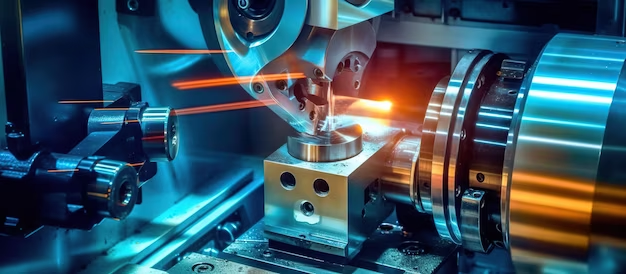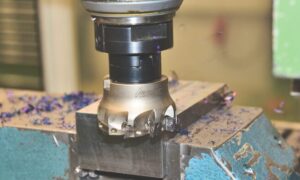The agricultural sector is our food superhero. It is the way farmers grow delicious fruits, vegetables, and grains that reach our tables. It is necessary because it provides us with the nutrients we need to be strong and healthy. Think of the world without agriculture as having no life on earth. It is crucial for all the living creatures on earth. The role of CNC is unremarkable in agriculture. CNC milling brightens the field of agriculture. It provides us with various advanced technologies and machines to ease our work. It facilitates us in sowing seeds to harvest the crops and make delicious food.
CNC milling is a manufacturing process that uses computer-controlled machines to remove material from a workpiece. CNC milling is like giving detailed instructions to the computer for cutting and creating different materials. CNC milling brings precision and efficiency to the world of manufacturing. In this article, we will thoroughly read the role of CNC milling in the agricultural industry.
Top Ten CNC milling parts for the agricultural industry:
In modern agriculture, CNC milling plays a pivotal role in composing essential components that drive efficiency on the farm. From planting to harvest, take a look at 10 CNC-machined parts that are changing the world of agriculture.
- Precision Seeder Components:
We use CNC milling to manufacture precision seeder components for precise seed placement during sowing.
- Customized Plow Blades:
A farmer can improve farming efficiency with his CNC-machined plow blades designed for specific soil conditions.
- Harvesting Knives:
CNC milling creates sharp, long-lasting knives for harvesters. It ensures clean and efficient crop cutting during harvesting.
- Fooding System Parts:
Spraying system parts such as nozzles and connectors are manufactured using CNC milling to achieve optimal water distribution in the field.
- Customized cultivation tools:
CNC machining allows you to create unique cultivation tools designed for specific crops and farming practices.
- Seeder Metering Components:
Precision-machined seeder metering system parts contribute to accurate seed spacing and distribution.
- Plant monitoring device enclosure:
We use CNC milling to manufacture electronic device sections for monitoring plant health. This provides continuity under various environmental conditions.
- Fertilizer Applicator Components:
Custom fertilizer applicator components are simulated using CNC milling for precise and efficient nutrient distribution.
- Soil Testing Equipment Parts:
CNC-machined soil testing equipment contributes to accurate soil analysis and helps farmers make informed crop management decisions.
- Grain handling system components:
Grain handling system components such as drills and conveyors are manufactured using these CNC milling machines for reliable and efficient grain transportation on the farm.
Components of CNC milling machines in agriculture:
In agriculture, CNC milling machines play an important role in manufacturing precision parts for various agricultural applications. The main components of agricultural CNC milling machines are:
- Controller
- Spindle
- Table
- Axes
- Cutting tools
- Tool changer
- Cooling system
- Guides
1. Controller:
The brain of a CNC mill machine is the controller. The controller solves programmed instructions and controls the movement of the machine.
2. Spindle:
The spindle holds the cutting tool and rotates at high speed. This high-speed rotation is made to engrave, shape, or cut the material.
3. Table:
The material to be processed is placed on the table. In agriculture, these can be components of agricultural machinery or parts of equipment.
4. Axes:
CNC milling machines have multiple axes that control the movement of the cutting tool. In agriculture, three-axis machines are common for tasks such as cutting and shaping.
5. Cutting Tools:
A cutting tool (often a drill or end mill) is a component that physically removes material during the milling process.
6. Tool changer:
Some agricultural CNC milling machines are equipped with a tool changer that automatically switches between different cutting tools. Tool changer allows you for more complex and efficient machining.
7. Cooling System:
To prevent overheating and maintain the quality of machined parts, CNC milling machines are often provided with a cooling system. The cooling system sprays the work area.
8. Guides:
These are precision railings that guide the movement of machine components and ensure accuracy in the milling process.
These components work together to enable CNC milling machines to produce exactly flawless parts for a variety of agricultural applications. These applications include planting and cultivation, harvesting, and equipment maintenance.
Advantages of CNC milling machines in agriculture:
Everything or material we are using today or in the past has its pros and cons. In the same way, CNC milling machines in the field of agriculture have their advantages and disadvantages. Let’s look up the advantages of agricultural milling machines first. Here are the few merits of using CNC milling machines in the application of farming and agriculture. It helps a lot to the poor farmers who worked day and night in the past to ripe their grains. Now, we can easily do all of the work with the help of machines instead of doing work with hands.
1. Precision agriculture:
CNC milling machines ensure high precision in the production of agricultural tools and components, contributing to accurate and efficient agricultural practices.
2. Customization:
Farmers can customize tools and parts to meet their specific needs, optimizing equipment for different crops, soil types, and farming methods.
3. Efficiency:
CNC milling machines increase the efficiency of various agricultural processes, from planting and cultivation to harvesting, by producing precise and consistent components.
4. Time Savings:
The automation and speed of CNC milling reduce the time needed to manufacture parts. Thus, farmers can focus more on their crops and farm management rather than their work.
5. Consistency:
CNC-machined components are often durable and wear-resistant. In this way, it extends the life of agricultural tools and equipment.
6. Versatility:
CNC milling machines can handle a variety of materials. So, it provides flexibility in manufacturing parts for a variety of agricultural applications.
7. Reduced labor cost:
CNC milling is the computer-based system of creating and producing machinery parts. So, it enables one to perform many tasks automatically. These automatic actions were performed manually by humans in the past. But today, self-made machinery does all those chores by itself. This process reduces labor costs and benefits us in that way. Therefore, the cost spent on giving them to laborers now can be utilized in some other best method.
- Digital prototyping:
The 3D designs of models are already made with the help of advanced technology. The engineers built designs before making a project. In this way, accurate prototypes are formed. These built-in prototypes require little or even no modifications before the final model of the machine and make it unable to work before the production of the actual machine.
Disadvantages of CNC Milling Machines in Agriculture:
We have discussed the advantages of the usage of CNC milling machines in the agriculture industry. Now we will talk about some of its disadvantages. These demerits have less importance regarding the merits of using CNC milling machines to shape the future of our country in the domain of harvesting and farming.
1. Initial Cost:
The initial cost of purchasing a CNC milling machine can be high and is not suitable for small or cash-strapped farms. It can be a hindrance.
2. Maintenance:
CNC machines must have skilled technicians for regular maintenance and repairs, which increases operating costs.
3. Complexity:
Operating and programming CNC machines require specialized skills, and some farmers may find it difficult to use the technology without proper training.
4. Mobility limitations:
CNC milling machines are usually fixed and can only be used in specific locations. This can be difficult when working with large farms or different field conditions.
5. Power Dependency:
CNC machines depend on a stable power source, and this dependence can be a disadvantage in areas with frequent power outages.
6. Material Limitations:
Although CNC machines are versatile, certain materials can be difficult to machine, which can affect the range of components that can be manufactured.
Examples of the types of agricultural parts:
Examples of the types of agricultural parts we can produce using the CNC milling process include the following:
- Air collector and valve components.
- Chain guide components.
- Pulleys.
- Spray system components.
- Sprockets.
- Tubing components.
Applications of CNC Milling in Agriculture:
CNC milling has different applications in agriculture and the farming industry. The few applications we will talk about. Below is the list of CNC milling applications in the domain of agriculture:
- Crop production
- Livestock farming
- Food processing
- Agricultural machinery
-
Crop Production:
CNC milling makes precise tools for planting and harvesting crops. It helps create special systems for watering plants properly.
-
Livestock Farming:
CNC milling helps build strong enclosures for animals on the farm. It crafts parts for keeping track of animal health.
-
Food Processing:
CNC milling creates parts for machines that process and pack food. It makes sure everything works smoothly in making our food.
-
Agricultural Machinery:
CNC machining creates strong parts for tractors and other farm machines. It helps the machines work well on the farm.
Challenges and limitations in CNC milling in the agricultural industry:
In the fasting and grooming world of farming, there are also some limitations and challenges. Along with high accuracy, CNC milling also offers some challenges that we have to solve. Let’s find out some restrictions that farmers face while using CNC milling services.
High Initial Costs:
CNC milling machines are quite expensive for farming and can be difficult for a farmer to buy at the beginning. They find it hard to invest much to buy these costly machines.
Skilled Operator Requirement:
Using CNC milling machines requires special skills. Technology is the invention of the modern era. The farmers are unaware of how to use this. It can be a challenge for them to find operators who know how to use these machines correctly.
Maintenance and Repairs:
CNC machines need regular care to keep them working well. To keep them maintained and accurate, we just need some skilled persons to check them out daily. It is difficult to find a man who knows how to operate these machines well.
Future of CNC milling in agriculture:
The use of CNC milling in agriculture has a bright and exciting future. By using CNC milling machines correctly, our country will flourish very well. Agriculture will become even more specialized and efficient with the continued use of CNC milling. To plant seeds and harvest crops with precision, farmers use incredibly precise machines. This is beneficial for all the population on the earth. Because the correct use of it provides us with a variety of healthy foods. This technological development helps farmers like an assistant in their work and boosts the reward of their hard work as an output. Smart farming equipment powered by CNC milling will be commonplace in fields of the future.
FAQS:
Here are some frequently asked questions about CNC machining and CNC milling. Take a glimpse over the few ones:
- What is CNC milling?
CNC milling is a machining process in which a moving tool makes precision cuts in stationary material. The materials cut by CNC milling machines are mostly metal, plastic, or wood.
- What does CNC stand for?
CNC stands for “Computer Numerical Controls”. A CNC milling machine operator uses a computer program to tell the machine exactly how to cut the material into the correct shape.
- What are the benefits of CNC milling?
CNC milling produces complex parts and components faster than humans and with the same precision each time the part is produced.
- What is the difference between CNC milling and turning?
The main difference between the two is that in CNC milling a rotating set of tools moves around a stationary material, whereas in CNC turning The tool is stationary and the material rotates at high speed. CNC turning is ideal for manufacturing cylindrical or hollow components because it rotates the material at high speeds.
In conclusion, CNC milling in agriculture is like a wise friend for farmers. It helps produce specialized tools and parts with utmost precision, making farming easier and crops healthier. CNC milling makes farming magical, creating a future where our food is grown with precision and care. It’s like an agricultural wizard who makes sure everything is done right in the field.






































